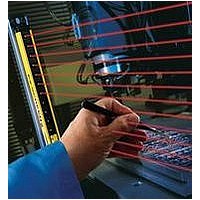QDE-825D BANNER ENGINEERING, QDE-825D Datasheet - Page 5

QDE-825D
Manufacturer Part Number
QDE-825D
Description
Safety Light Curtain
Manufacturer
BANNER ENGINEERING
Datasheet
1.QDE-815D.pdf
(74 pages)
Specifications of QDE-825D
Light Curtain Type
Safety
Accessory Type
Machine Interface Cable
For Use With
EZ-Screen Safety Light Screen
EZ-SCREEN
Instruction Manual
The Banner EZ-SCREEN models described by this manual
feature several standard selectable functions:
• Reduced Resolution (Floating Blanking),
• Trip or Latch Output,
• External Device Monitoring (EDM),
• Auxiliary Output,
• Scan Code setting,
• Fixed Blanking,
• Inverted Display, and
• Cascading (available on SLSC.. models).
These functions are configured within the sensors, behind the
access cover on the front of each sensor and in the sensor
wiring configuration; see Sections 3 and 4.2 for more information
and configuration DIP switches.
The resolution and the maximum range can be determined by
the model number on the emitter and receiver. See Section 2 for
a list of model numbers.
The setting for Trip or Latch Output also determines whether the
System will enter RUN mode automatically or if it will require a
manual reset first (see Sections 1.4.8 and 4.2). If the System is
set for Trip Output, other measures must be taken to prevent a
pass-through hazard; see Section 3.1.2 and the warning below
for more information.
If Trip Output is selected, the OSSD outputs will turn ON after
power is applied, and the receiver passes its internal self-test/
synchronization and recognizes that all beams are clear. The
Trip Output will also automatically reset after all beams are
cleared. If Latch Output is selected, the EZ-SCREEN requires
a manual reset for the OSSD outputs to turn ON, after power is
applied and all beams are clear (see Section 4.5).
1.4 Operating Features
1.4.1 Selectable Trip/Latch Output
Application of power to the EZ-SCREEN components, the
clearing of the defined area, or the reset of a Latch condition
MUST NOT initiate dangerous machine motion. Machine control
circuitry must be designed so that one or more initiation devices
must be engaged (i.e., a conscious act) to start the machine – in
addition to the EZ-SCREEN going into RUN mode. Failure to follow
these instructions could result in serious bodily injury or death.
Banner Engineering Corp.
Banner Engineering Corp.
www.bannerengineering.com • Tel: 763.544.3164
www.bannerengineering.com • Tel: 763.544.3164
WARNING . . .
•
•
Minneapolis, U.S.A.
Minneapolis, U.S.A.
Use of Trip/Latch Output
An EZ-SCREEN emitter with an 8-pin connector can be
connected to its own power supply or to the receiver cable
color-for-color (see Figures 3-19 and 3-20). The color-for-
color hookup allows the emitter and receiver positions to be
interchanged without rewiring.
NOTE: An EZ-SCREEN emitter with 5-pin connector and Test
This feature allows the EZ-SCREEN System to monitor the
status of external devices, such as MPCEs. The choices are
1- or 2-channel monitoring, or no monitoring. EDM is used when
the EZ-SCREEN OSSD outputs directly control the MPCEs or
other external devices; see Sections 3.5.3 and 4.2 for more
information.
Auxiliary (Aux.) Output
An aux. output function is available when the receiver is
configured for 1-channel EDM (for receivers with date code
0834 or newer). This current sourcing (PNP) solid-state output
(75 mA max.) is used for control functions that are not safety-
related. A typical use is to signal the state of the OSSDs to a
programmable logic controller (PLC). The aux. output follows
the state of the OSSDs. Pin 2 (orange/black) supplies the
connection; see Section 3.5.5 and Figure 3-23.
On 5-pin EZ-SCREEN emitter models (model numbers SLSE..-..
Q5; see Tables 2.1 and 2.2), a Test function is provided. A pair
of wires is connected from the emitter (see Section 3.5.6) to an
external switch, typically a normally open contact, held closed.
Opening a switch connected between these two terminals “turns
off” the emitter, simulating an interruption of one or more light
beams. This remote Test input may be useful for EZ-SCREEN
System setup and to verify machine control circuit operation.
The emitter and receiver may be configured to one of two
Scan Code positions (1 or 2). Scan codes enable a receiver
to recognize beams only from an emitter with the same Scan
Code setting. This helps minimize the effects of crosstalk
between multiple emitter/receiver pairs, and allows multiple
pairs to operate in close proximity in certain situations. See
Sections 3.1.5 and 3.1.8 for proper mounting configurations.
The Scan Code is set using the selection switch in each
sensor’s configuration port; see Section 4.2 for more
information. Both the emitter and its corresponding receiver
must be set to the identical setting.
1.4.2 Emitter QD and Hookup Options
1.4.3 External Device Monitoring (EDM)
1.4.4 Remote Test Input
1.4.5 Scan Code Configuration
function (see Section 1.4.4) is not capable of the color-
for-color hookup.
Overview
Overview
P/N 112852 rev. F
P/N 133487
3
3














